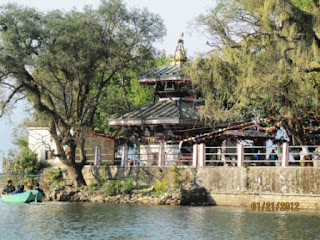Claire thought there might be a
“bund” on Thursday. That’s a strike. I don’t really understand how it works,
but whenever someone is unhappy with the government (and there is a great deal
to be unhappy about these days, I’m told), they call for a bund. No one goes to
work, no one opens shops, no one drives. The town stops. Power to the people,
but I had a plane to catch. Claire suggested we get up early and take our
morning walk to the airport, pulling suitcases, about an hour and a half. So we
did get up early, but I can’t say I’m too sorry the bund didn’t happen. It
would have been a bit much at the beginning of a two-day, four-country, four-plane
trip, especially one through Delhi.
 |
| The Sthapit home |
Instead I had time for a few
pictures and many goodbyes. Then Claire and I drove to Lakeside and drank
coffee and watched the fog over the water, wondering why this day of all days the
visibility would be so bad, and whether the airport would shut down. The planes
to Pokhara fly by sight rather than instruments, and the mountains are so close
that they can’t fly in and out with fog. This could have been a problem—last
time I came, we ended up having to drive to Kathmandu in a van. It’s only 120
miles but it takes all day. Planes were delayed, but not badly enough to miss
connections this time. I made it fine to Kathmandu, collected my luggage,
dragged it down the dirt hill I had dragged it up two weeks before, and into
the international terminal, while an airport official walked beside me telling
me how corrupt the government is and how little gets done there.

And then to Delhi, where I joyously
passed up the international transit wardens and the detention center I’d had
such fond memories of two weeks before. Picking up luggage and exiting the
airport is actually much easier than being a transit passenger. Outside I met
Sajal’s dad Bhuwon. We had dinner and wine and talked about Nepal (also about
government corruption and the infrastructure that could have been built if
parties weren’t bickering all the time) the families, and work. He goes all
over—two trips to Rome in February, then to Thailand and Tamil Nadu in March.
He works with indigenous farmers all over the eastern hemisphere—in Africa,
Southeast Asia, the “—istan” countries—promoting biodiversity and sustainable
farming practices. It’s all extremely interesting. The downside is that he is
hardly ever home, and has to maintain an apartment in Delhi. It’s a lovely home
with five balconies—but it overlooks Delhi.
 |
| The Himalayas from air |
I slept about three hours before
getting up at 2:00 for coffee and a trip through quiet, smog-filled streets to
the airport. I think must reward bad behavior with detention hall duty—all the
officials I dealt with at the check-in counter were sane and reasonable. Nothing
bad happened, and the plane left almost on time. I’ll change planes in Istanbul
and, God and Turkish airlines willing, land in Tel Aviv shortly after the group
flying from Louisville does.
Here is one last shot of the
Himalayas from the Kathmandu-Delhi plane.


























